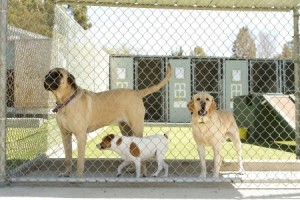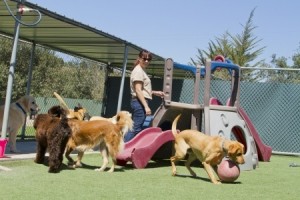
Are you looking for another dog to keep you and your other dogs company? Or maybe you’re thinking about getting a dog for the very first time. The best place to find a loving dog to join your family is by adopting through your local animal shelter or rescue organization; shelters and rescue groups always have a great selection of dogs that are eagerly looking for a new home. Adopting a dog is a big decision – dogs are living creatures and you will be responsible for their care for many years to come. Making the decision on which dog to adopt is a decision that should be made with thought and care, so here are some tips to help you find your new best friend.
Why Dogs Are Surrendered to Shelters
Somewhere between 6-8 million pets end up in shelters each year, and unfortunately approximately half of them will not be adopted. Most dogs are brought to shelters because of situations beyond their control. Dogs are often surrendered to shelters because their owners decided to move without them, or the owners are experiencing landlord issues. Other dogs are surrendered by people who are going through family changes such as a death in the family, a family illness, or the addition of a new baby. Other common reasons why dogs are brought to shelters are because the current owner cannot afford the cost of pet care, no longer has time to take care of the dog, or the pet parents did not learn how to provide basic training and the dog is surrendered for “behavioral” issues, such as not being house trained. Sometimes dogs are brought to shelters because they grew out of the cute puppy stage and are now bigger, stronger and require more training, food and veterinarian care. And too often dogs are taken to shelters because the owners had initially adopted the dog because it was cute or the breed was “fashionable” at the time, and the owner did not research the dog’s energy level or behavior.
Why Adopting Is Best
Shelters and rescue organizations have a huge selection of dogs that you can choose from. You can find all types of mixed breeds, pure bred dogs, and all sorts of different shapes, sizes and age groups. Many of the dogs in shelters or with rescue groups have already lived with families, so usually they already have basic social skills and are wonderful, family-ready pets that are looking for a new home. Most shelters and rescue groups conduct a thorough behavioral analysis of each dog to make sure they are the right fit for your family; they also vaccinate, spay/neuter, deworm and microchip the dogs and take care of any medical issues that need to be addressed before the dogs are adopted. And thanks to the hard work of the volunteers at the shelters and rescue groups, most dogs are given basic house training and obedience training skills before they are adopted. With approximately 4 million dogs and cats euthanized each year in U.S. shelters, there is a great need for people to adopt these dogs; by adopting a dog from a shelter or rescue group, you are giving this dog a second chance and this will be a rewarding experience for both you and the dog.
Planning Ahead – Finding Your Match
The first step before adopting a dog is to identify what your lifestyle is like. Are you an active person who is looking for a hiking or running companion that you can take everywhere with you? Or do you have a family and you’re looking for a dog who loves children? Maybe you have other dogs and cats and are looking for a dog that will fit in with the rest of your pets. Make a list of what you’re looking for in a dog, including what size dog you would like, do you want a dog with short easy-to-care hair, and what age range are you looking for? Here are some basic questions to ask yourself before you start your search.
Energy Level and Lifestyle– If you are an active person who enjoys hiking, jogging and going to parks, then most likely you’ll want a dog that matches your energy level. On the other hand, if you have a quiet, sedentary lifestyle then you would be better matched with a quieter, laid back dog instead of one with a lot of energy. When there is a big conflict in energy levels (you like to sleep late on weekends and you have a dog that is full of zoomies at 5:00AM), tension and issues quickly arise. So do some research on dog breeds and their energy levels; all dogs are different so while the breed might not necessarily dictate the personality of each dog, it can give you an idea as to what types of dogs are known for high energy levels versus more laid back breeds. Also, look at any space restrictions you might have – do you have a large yard for your dog or easy access to dog parks where you can take your dog to play? If you live in an apartment, then you’ll want to select a dog that best fits your home living arrangements. Of course, if you live in an apartment you’ll want to check first as to whether or not pets are allowed in your building and what restrictions, if any, there might be.
Age Range – Without a doubt, puppies are cuddly, adorable and a lot of fun. But puppyhood lasts for just a short time (birth to 8 months) and then adolescence to adulthood sets in. And before you know it, you have a full size, mature adult dog living with you. Raising a puppy properly takes a lot of time and work, and puppies usually require a lot more time and attention than a mature dog. If there are young children in your household a puppy may not be your best bet; not all dogs are good with small children, plus you might not have enough time to train your puppy and before you know it, you have an adult dog that jumps on people, begs for food and does not have basic manners. So while it may be tempting to adopt a puppy for your child, this might not be the best choice. As a side note, regardless of the age or breed mix dog that you decide to adopt, if you have young children at home you should make sure to supervise all dog and small children interactions and separate them when they are alone.
Adult dogs are often overlooked at shelters or from rescue organizations, and are typically the last to be adopted – but adult dogs often make the best pets! Typically adult dogs are well house trained, they know their basic manners and they no longer find joy in tearing up newspaper or shoes. Usually they are calmer and more settled, and are easy to take for walks or go for rides in the car. Adult dogs are also good to adopt because you pretty much know from the start what their full-grown size is, how much grooming will be involved, and what their personality and temperament is like. With an older dog, there rarely are any surprises, and they are also easy to train since they are calmer and more focused than younger dogs.
Purebred or Mixed-breed – If you’re looking for a purebred dog, approximately 25-30 percent of dogs in shelters are pure breed, so chances are good that you’ll be able to find the breed you’re looking for at a shelter. Also, there are many rescue organizations that are breed specific and they, too, can help you locate and adopt the breed that you’re interested in. Mixed-breed dogs (mutts) are also plentiful in shelters and in rescue organizations, and quite often mixed-breed dogs make the best pets since they are a combination of all the great traits in their genetic make-up and do not carry recessive genes that can be found in purebred dogs.
Primary Caretaker – Another important question to ask yourself and your family is who is going to be the primary caretaker of the dog? With today’s busy schedules, most likely both parents are working and the kids are in school, involved in sports or participate in other after-school activities. So you’ll need to decide in advance who’s going to be responsible for feeding, cleaning up and walking your new dog. If you have several kids, you can assign different responsibilities to each child or you can set up a rotating doggie care schedule and keep it posted on your refrigerator or community household bulletin board. If you live alone, you’ll need to think about how to take care of your dog when you’re away on business trips or traveling for vacation (either in-home care or find a reputable boarding facility). If you tend to travel a lot and are gone most days and evenings, then adopting a dog might not be the right pet for you, as dogs are companion animals and need both exercise and human companionship.
Beginning Your Search – Adopting a dog has become a lot easier now that you can initially search online for dogs in your area. Most animal shelters and adoption agencies have websites where you can browse available dogs and even narrow your search by gender, age, size and breed. Most shelters and rescue groups have their adoptable dogs listed on large nationwide sites such as PetFinder.com or AdoptAPet.com. The advantage to searching online first is you can explore the sites and see in advance what dogs are available for adoption, and then you can set up an appointment to meet the dog or dogs that you are interested in adopting.
Shelters and Rescue Organizations
There are some differences between shelters and rescue groups, and both can help you in your decision in adopting a dog by providing advice and guidance on which dogs are best suited for your living situation. Volunteers at both places interact with the dogs daily, so they know the dogs and they can help recommend which ones are more likely to be a good match for you.
Animal shelters (also called Animal Control or “the pound”) do not turn away animals and will take in any dog (or cat) that is brought to them or picked up by Animal Control officers, so most shelters are at full capacity most of the time. Quite often the dogs at shelters have an unknown history, though the volunteers will be able to tell you what they know about the dog and what they’ve observed while the dog has been in their care. Most shelters have a play area where you can take the dog out of his kennel and get to know him a little better before you adopt. Animal shelters can get quite busy during weekends, so you might want to go in the middle of the week or during off hours when it’s a little less crowded and you can spend as much time as you need to with the dogs. If you find that you like a dog at the shelter that was brought in as a stray, you’ll have to wait a few days to see if the owner comes to claim the dog, but you can still call each day to check on his status and let them know you’re still interested.
Rescue organizations are non-profit organizations and are limited in the number of dogs that they can take in. Most rescue organizations rely on volunteers to provide foster homes or use boarding kennels to house the dogs until they are adopted. Rescue organizations will also work with animal shelters and take in some dogs from the shelters in an effort to help get them adopted.
Both shelters and rescues will have you fill out an adoption application and conduct an interview, and will often visit your home before and after the adoption to make sure it’s a suitable match. Some will also ask for references and will check before they allow you to adopt the dog. Rescue organizations can often bring the dog that you’re interested in over to your house first for a “play date” if you have other animals to see how they get along. Both shelters and rescues are dedicated to providing a “forever home” for the dog and are dedicated to finding good homes for the dogs in their care, so these are all great safeguards that can help reduce the chances of the dog being returned to the shelter or rescue group. You can find your local rescues and shelters at here.
During Your Visit
Now that you’ve selected which dogs you’re interested in and which shelters and rescue organizations you’d like to visit, give them a call to set up an appointment so you can meet your potential matches. While you are there, you’ll want to ask as many questions as possible from the workers and volunteers that have experience with the dog and can tell what they know and have observed. Some of your questions may include:
- How old is the dog and what breed(s) do you think he is?
- Do you know anything about the dog’s history and where he came from (was he a stray, surrendered by owner, transferred from another shelter)?
- Are there any health concerns that you are aware of and if so, what medication(s) is he taking?
- Are there any behavioral problems that you know about (digging, chewing, barking)?
- Is the dog spayed or neutered, dewormed, vaccinated and microchipped? If not, can they do it before you bring the dog home?
- Did you conduct a behavioral evaluation on the dog and what were the results?
- How would you describe his personality? Is he outgoing, calm, shy, energetic, etc.?
- How is he with children, other dogs and cats?
- How does he act around food and toys – is he possessive?
- What kind of training does he have (house trained, walks on a leash, knows basic commands)?
- How is he in the car?
- Do they allow play dates in advance so he can meet your other dogs?
Remember that the dogs at shelters or at rescue groups can be stressed by their environment by living next to barking dogs and being housed in cages, so it’s important to spend time alone with the dog in a less stressful setting and also interact with the volunteers to find out what they’ve observed about the dog you’re interested in. Most shelters or rescue groups have a play area where you can spend some quiet time with the dog, take him for a walk, and get to know him a little better in a quiet, relaxed setting. When meeting the dog for the first time, see if he is happy to be touched and pet, does he wag his tail and does he like attention? Does he want to play with you or is he a mellow type of dog? How is he on the leash and walking with you? Does he focus on you or his he more interested in his environment? These are all factors that will help you decide if he’s a good fit for you. Also, do your best to avoid snap judgments and avoid making an emotional decision when trying to select your dog. Going to a shelter can be hard emotionally as you probably want to bring each and every dog home with you! So do your best to put your emotions aside because In the long run, both you and your newly adopted dog will be happiest if you choose the dog that is best fitted for you.
Bringing Your Dog Home
Congratulations! You’ve found the dog that you want to adopt and bring home to live with you and your family! The rescue group or shelter will have you complete the necessary paperwork, finalize the microchipping process and will schedule an in-home visit to check up on the dog within the next few weeks. You’ll need to make sure to have some supplies for your new dog including a fitted collar and leash, and ID tag with your address and phone number, bowls for food and water , grooming supplies, a dog bed, nutritious dog food, dog toys, and quality supplements such as InflamAway HA if you are adopting an adult dog.
Once you’ve brought your dog home, realize that it will probably takes some time for you and your dog to get to know each other. Your dog has just moved from one unfamiliar environment to another, and there will definitely be an adjustment period. Your dog is now in a new setting and doesn’t yet know the rules, so it’ll take him some time to learn what is expected of him in his new home. You can help your dog by not leaving out tempting articles like shoes, children’s toys, or full trash cans in the kitchen. If you have a cat, set up a safe room where your cat can hide if he wants to (just put up a baby gate to separate the room from the rest of the house where he can eat, sleep and use the litter box). If you have other dogs, you’ll want to introduce them slowly and give them plenty of extra attention so they do not become jealous. Take your new dog outside every few hours and praise him when he relieves himself outdoors; this will help reinforce where he should go. Be prepared for accidents – even house trained dogs can have accidents when there is a major change in their life and environment. If your dog is recently neutered, he may initially leg lift indoors, so be patient and work with him on going outside to relieve himself. Also, you can help your dog adjust to his new home and his new schedule by setting up a routine schedule of feeding, going outside and play time. Setting up a schedule will help him feel more secure and will help him understand the rules of his new home.
Adopting a dog from a rescue or shelter is such a rewarding experience and the two of you will be bonded in no time! If you have ever adopted a dog, tell us about it – we’d love to hear your stories.








Leave a Reply